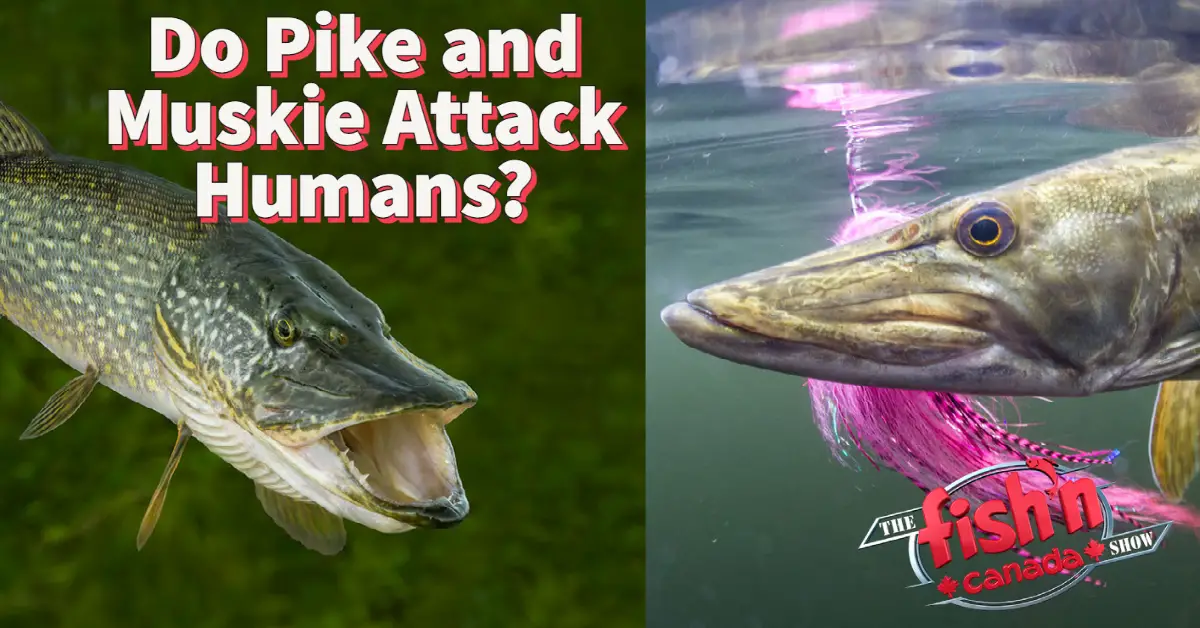As a young kid in southern Ontario, few fish occupied my mind more than Pike and Muskie. On one hand, as a young angler, catching a fish measuring nearly as long as myself was the stuff of dreams. On the other, as someone who just as frequently liked to swim in the lakes that these fish call home – the dreams quickly turned to nightmares. Despite the Jaws-like scenes that played out in my mind every time I jumped off the dock, these nightmares thankfully never came true. There have, however, been a few people over the years who haven’t been so lucky.
Lakeside Caravan Park, Wales: 1999
One of the few confirmed cases of a Northern Pike attacking a human occurred across the pond at a small lakeside resort in southern Wales. This lake is renowned for its Pike fishing and produces trophy fish on an annual basis.
While out water skiing, tourist Darren Blake came across one of these trophies in the worst way possible when a giant Northern latched onto his ankle while he was standing in the water waiting for his friends to pick him up. Although the wound was deep and likely required a few stitches, the Pike reportedly let go of Darren’s foot almost immediately after realizing its target was much larger than it had once thought (The Guardian, 1999).
The full story of this attack can be found here
Island Lake, Minnesota: 2017
Another unfortunate case of mistaken identity was seen on Island Lake in Minnesota in 2017 – though the damage was much more severe.
11-year old Maren Kesselhon was paddleboarding with her family one summer afternoon when they decided to take a break near the local boat launch. This peaceful scene quickly turned gruesome when Maren’s leg was grabbed from beneath the paddleboard by what was later suspected to be a large Muskie. This wound amounted to over 25 separate lacerations and required surgery to repair the damaged tendons (Cook, 2017).
The full story of this attack, as well as pictures of the wound, can be found here
Minaki, Ontario: 2020
One of the most recent, and perhaps the most unique, reports of these fish attacking humans occurred just last year when Winnipeg woman, Kim Driver, was swimming at a local fishing resort in Minaki, Ontario.
This attack came in chest-deep water when a 50” Muskie grabbed her by her calf and proceeded to shake and pull until she was completely submerged. Though she thankfully did get free, the wound left by the fish required extensive plastic surgery and will surely leave a scarring memory.
Kim and her husband Terry were kind enough to share their story with Fish’n Canada last July, just after the incident had occurred. The full interview can be found here
What Caused These Fish to Attack?
Similar to many of the cases we see with sharks, Pike and Muskie attacks can often be chalked up to mistaken identity. This occurs when a fish misjudges something as prey and instinctually attacks before further examining its target. This is why the vast majority of Pike and Muskie attacks occur when only small sections of the body, such as fingers and toes, can be seen by the fish. This is also why, when these attacks do occur, the fish almost always let go shortly after latching on to the heavier-than-expected subject.
As seen in our third story, however, this is not what happened in Minaki. During an interview with Ang and Pete last summer, Kim confirmed that she was attacked while standing in chest-deep, crystal clear water. Does this mean that some Muskie are willing to attack prey that much larger than themselves?
In seeking answers to this question, my mind began wandering to saltwater. Lifeguards in tropical locations with large Barracuda populations often warn swimmers about wearing jewelry as large predators can be easily lured in by shiny objects. In fact, these predators’ single-minded pursuit of the prospective bait can often lead them to ignore the overall size of the person they are approaching as they zone in on the small, flashy target. Could this explain this unique attack? After all, many Pike and Muskie baits mimic exactly this, using flashy silver and gold metal paired with rapid movement to entice big fish to strike.
Unfortunately, while this theory may be true for Barracuda, it did not seem to be the case in this particular situation as Kim did not appear to have any jewelry on at the time of the attack. Instead, the muskie’s poor eyesight, the sporadic movements of swimmers, and plain old bad luck are likely to blame in this unique case.
First Hand Experience
Although I have thankfully never been “attacked” by one of these fish, my experience as a Pike angler and guide has brought my hands far too close to their toothy mouths more times than I can count. While these injuries are often little more than a scratch, an incident a few summers ago showed me another danger these fish can pose.
In 2019, while guiding a fly-out Bass and Pike trip in the Manitoba backcountry, I carelessly attempted to remove a deep hook with my bare hands to allow my client to get back into the water and onto another fish we had spotted in the area. This decision was instantly regretted when the jaw spreaders that were holding the fish’s mouth open sprung out and allowed the fish to clamp down on my thumb. Though the injury appeared to be relatively minor, the timing of the bite turned out to be much more of an issue.
The bite took place early in the morning and rather than spending my clients time sanitizing my wounds, I decided that toilet paper and hockey tape would do the trick until I got back to camp. After flying back to camp and eventually sanitizing the cut (over 12 hours later), I decided to head to bed. Upon waking up and removing the homemade Canadian bandage, I noticed multiple blisters forming on my hand. Thinking nothing of it and having new guests waiting for me in camp, I decided to fashion another bandage and head out for the day. By the end of the day, these two blisters had turned to 20, warranting a five-hour ride to the local hospital, where I was told my hands were infected with a waterborne bacteria stemming from the Pike’s bite.

Though this Pike-related injury was more my doing than any fish’s, it at least highlights the importance of washing and sanitizing your hands after dealing with fish, as species such as Northern Pike are host to a number of nasty bacteria that are far more of a threat to humans than one of them stalking your evening swim.
References:
Aiken, M., 2020. Muskie Attack Was ‘Terrifying’. [online] Kenora Online. Available at: <https://kenoraonline.com/local/muskie-attack-was-terrifying> [Accessed 11 August 2020].
Cook, S., 2017. Muskie Attack? Girl, 11, Recovering From Scary Encounter On Minnesota Lake – Twin Cities. [online] Twincities.com. Available at: <https://www.twincities.com/2017/07/21/muskie-attack-girl-11-recovering-from-scary-encounter-on-minnesota-lake/> [Accessed 11 August 2020].
The Guardian. 1999. Water Skier Bitten By Giant Pike. [online] Available at: <https://www.theguardian.com/uk/1999/sep/01/2> [Accessed 11 August 2020].






